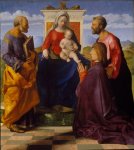In the age of Giorgione – Royal Academy
Up to the Sackler Wing – the lift was working – to see the Royal Academy’s exhibition of Giorgione (1477 – 1510) and others from the Venetian High Renaissance. The title of the show puts one in mind of a CD featuring European disco hits from the 1980s. Perhaps it would be better entitled in search of Giorgione because, truth be told, there are very few paintings in the collection which can be definitively attributed to Giorgio da Castelfranco, erstwhile trainee of Bellini.
But there is one which can and was for me the stand-out painting in the exhibition, La Vecchia, which is almost the direct antithesis of da Vinci’s Mona Lisa, painted around the same time. Here we have an old woman with crumpled, time ravaged skin and stumps for teeth, grey strands of hair dressed in ragged clothes, with the legend “Col tempo” in her hand. What impressed me was the immediacy and vividness of the image. Compared to the ethereal Mona Lisa, this is real life in the raw. Her pose, the sensitive brushwork and the delicate portrayal of light reveal a Renaissance artist at the height of his powers but one who is interested in reality rather than Platonic ideals.
The other overwhelming theme is one of melancholy. The portraits are of fragile humans with wistful, lovelorn expressions, gazing out at us for pity and sympathy. It is hard not to think that this reflects the world-view of an artist, conscious that he only had a short time on earth. According to Vasari Giorgione died at the age of 32 on the quarantine island of Lazarretto Nuovo where the Venetian republic put those exposed to the plague. It is said that he was also a brilliant musician and courted his female lovers by playing the lute under their balconies. Alas, it was from one of these lovers that he contracted the plague that did for him.
As a bit of a jack-the-lad Giorgione wasn’t above luring his paramours to some quiet glade and persuading them to disrobe. The world of art benefitted from this rather direct approach. Giorgione prototyped the knowing, carnal nude, a style imitated and enhanced by his younger contemporary, Titian. He laid the foundations upon which Titian and, to some extent, his tutor, Bellini, built.
There are four rooms, featuring portraits, landscapes, devotional works and allegorical paintings, Giorgione’s works being augmented by contributions from contemporary Venetian painters, including Titian, Bellini, Durer and Lorenzo Lotto. There were some rather ugly representations of Christ in the devotional section. Titian’s Christ and the Adulteress, previously attributed to Giorgione, was particularly powerful in its imagery and movement. And the beginning of the development of landscape as a genre in itself rather than just a background to a portrait or allegorical scene and which became a defining feature of Venetian art was interesting to observe. But even Giorgione’s treatment of a pastoral scene seemed laced with melancholy.
I enjoyed this exhibition which gave me a fascinating insight into an artist whose work though few in number was highly influential. Perhaps, to echo, Dante, that was his fate.


